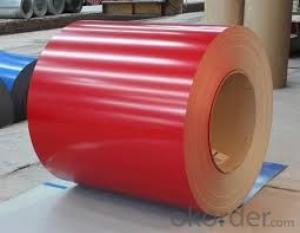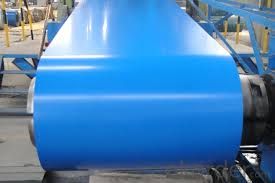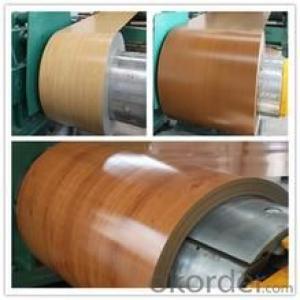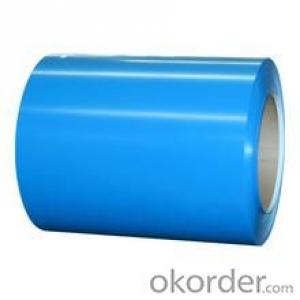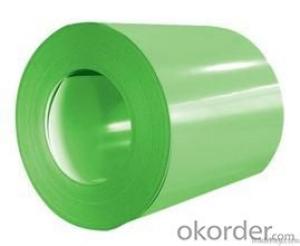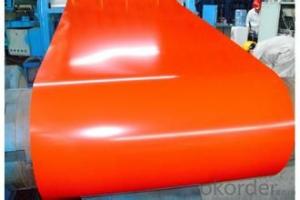Prepainted galvanized rolled Steel Coil -in China
- Loading Port:
- Tianjin
- Payment Terms:
- TT OR LC
- Min Order Qty:
- 100 m.t.
- Supply Capability:
- 500000 m.t./month
OKorder Service Pledge
OKorder Financial Service
You Might Also Like
Brief Introduction
Prepainted Galvanized Steel usually refers to have substrateprocessed with surface processed and coated then(roller coated )or bonded organic thin film and baked, and it is able to be processed tofinal prodevtion .
PrepaintedGalvanized Steel qualified with excellent decorative ,formability ,corrosionresistance ,coating adhesion ,can keep for a long time as well as maintainfresh color .For color coated steel sheet can obtain good economicbenefit by steel belt wood ,efficient in construction and save energy ,preventpollution etc.Which is an ideal material;for manufacturing board.
Sample Charge
1.Samples charge:According to your requirements . Sampling time:30days with minimum qty order.
2.Samples charge:Free for Existing Samples Sampling time:1day
Advantage
1. Low MOQ: We will do our best to make you satisfied.
2.Good Service : We treat clients as friend.
3.Good Quality :We have strict quality control system .Good reputation in the market.
4.Fast & Cheap Delivery: We have big discount from forwarder (Long Contract).
5.Supply Ability: 50000 ton monthly
Specifications OfPrepainted Galvanized Steel
Thickness 0.20-1.2mm (BMT) Width 600-1250mm |
Zinc Coating 100-275g/m2 |
Color According to RAL color fan or as per request |
Internal Diameter 508mm or 610mm |
Coil Weight 3-6MT |
Quality Commercial and structural quality |
Paint Polyester paint for topside, epoxy for reverse |
Standard JIS G 3312, ASTM A755M, EN 10169 |
Base Steel Grade SGCC,SGCD,DX51D+Z,DX52D+Z;S200GD,S220GD,S280GD,S350GD,CS,FS,SS |
Chemical Composition Of Prepainted Galvanized Steel
C | Si | Mn | P |
0.04-0.06% | 0.01-0.03% | 0.18-0.22% | 0.014-0.016% |
Technical Data Of Prepainted Galvanized Steel
Yield Strength | (Mpa) 280-320 |
Tensile Strength | (Mpa) 340-390 |
Elongation | 20%-30% |
Reverse Impact | 9J |
T-bending | ≥2T |
Pencil Hardness | ≥2H |
Duration Of Salt Spray Test | 500 H |
Bending At 180 Degree | No crack, purling and fraction |
Applications OfPrepainted Galvanized Steel
It can be widely used in transportation, light industry, civil usage and farming. It is also the perfect building material in construction for making steel roofing,insulation panel, corrugate sheet, facade wall,shutters,T-bar and home appliance.
Packaging & Delivery Of Prepainted Galvanized Steel
The packing of coils consists of anti-damp paper, PVC film, hardboard paper, steel box, strapped with steel strips, fitted with locks and edge protectors and guarantees the optimal condition of the delivered goods. Each coil can be additionally fitted with wooden/steel skids(eye to the side) or wooden pallets(eye to the sky).
General Order Information
We take great pride in our work and in the wide variety of products that we offer. We are
experienced in servicing the Middle East market, South America market and Africa market .
Please be aware thatour production lead times depend on specific items and item quantities.
Our success has been basedon our understanding of the demands and nature of marketing deadlines.
That'swhy we always ensure that every order is delivered on time.
- Q: That's my question, well that and:Steel Pick + Electric Guitar = Trashed Guitar?:D
- Uh. . . your guitar would be okay. . . except your strings wouldn't last long then nylon strings.
- Q: Are steel buildings or homes better then wooden buildings? Why?
- Steel is better than wood. Steel can support more weight than wood. Steel is also much more durable than wood. Termites and rot are not a problem, which results in lower maintenance cost later. Also, wood can rot and warp whereas steel will not. Steel is also more economical than wood. The construction requires less labor, and as a result the labor cost is much lower. Steel is fire resistant, which will lower insurance costs.
- Q: What is the average lifespan of a steel coil?
- Several factors can influence the average lifespan of a steel coil. These factors encompass the quality and type of steel utilized, the conditions in which the coil is stored or used, and the maintenance and care it receives. Typically, a steel coil that is well-maintained can endure for approximately 10 to 30 years. Nevertheless, this is merely an approximation, and the actual lifespan can be either shorter or longer depending on the aforementioned factors. For example, if the coil is exposed to severe environmental conditions, such as extreme temperatures or corrosive elements, its lifespan may be diminished. Regular upkeep and proper storage can significantly prolong the longevity of a steel coil. This entails ensuring that the coil is stored in a dry and safeguarded environment, frequently inspecting and addressing any indications of corrosion or damage, and conducting routine cleaning and lubrication as necessary. Ultimately, the average lifespan of a steel coil is contingent upon various factors, and it is advisable to consult the manufacturer or industry experts for a more precise estimation based on specific circumstances and conditions.
- Q: What are the factors influencing the price of steel coils?
- There are several factors that influence the price of steel coils. 1. Raw material costs: The price of steel coils is directly impacted by the cost of raw materials, such as iron ore and coal. Fluctuations in these commodity prices can greatly affect the overall price of steel coils. 2. Demand and supply: The supply and demand dynamics in the steel industry play a significant role in determining the price of steel coils. If there is a high demand for steel products, the price of steel coils is likely to increase. Conversely, if there is an oversupply of steel, prices may decrease. 3. Production and manufacturing costs: The cost of producing and manufacturing steel coils, including labor, energy, and transportation costs, can impact the final price of the product. Any changes in these costs can influence the overall price of steel coils. 4. Currency exchange rates: Steel is a global commodity, and its price can be influenced by fluctuations in currency exchange rates. If the currency in which steel is traded weakens against other currencies, it can result in higher prices for steel coils. 5. Government regulations and policies: Government regulations and policies, such as import tariffs, export restrictions, and environmental regulations, can impact the price of steel coils. These regulations can affect the cost of production and trade, ultimately influencing the price of steel coils. 6. Market competition: The level of competition among steel manufacturers and suppliers can also impact the price of steel coils. If there are multiple suppliers and manufacturers in the market, it can lead to competitive pricing, potentially driving down the price. On the other hand, if the market is dominated by a few suppliers, prices may be higher. It is important to note that these factors can vary over time and in different regions, ultimately affecting the pricing of steel coils in the market.
- Q: Can steel coils be coated with epoxy?
- Yes, steel coils can be coated with epoxy. Epoxy coatings are commonly used to protect steel from corrosion and provide a durable finish.
- Q: This question gets beat to death from what ive seen online but im going to ask it since im searching for a few new knives. The question is as the titles states what is the best steel for a general purpose knife? I plan on buying several different types of knives, Folders, fixed blades, ect. I will carry them around with me all the time for basically anything i can think of to use it for. The reason i ask this question here is because looking online everyone has a differnt veiw. Some say stainless is too soft while others say carbon will chip and is more brittle. Even looking at just a single type of steel, carbon fort instance everyone has a different opinion as to whats best leaving me kind of lost for what i should get. Maybe the better word would be What is a good general purpose steel?. Any advice is much appreciated!!!!
- Do you want apples or oranges? It's that kind of question. Here's my opinion. For large blades (over 6) 5160 or L-6 done properly makes a nearly unbreakable knife. I once pulled my 65lb vice out of the work bench with an 8 L-6 blade. As carbon content goes up edge holding increases but at the cost of overall strength. For smaller blades I prefer O-1 and 52100, these steels have about twice the edge holding as 5160 but cannot pass the 90deg bend test without breaking. 1095 is a fine steel, I prefer to make damascus from it, but when I do make a blade I want to show a temper line as this steel will do it well. Then we get into high alloy, D-2 is about as balanced as they come and for a smaller blade is second to none save the CPM steels. The CPM steels are very expensive and like the homogonous steel come in many alloys. As far as a chipping edge, that's more an indication of improper heat treating than anything. Carbon steel has more strength and edge holding potential than stainless. D-2 has enough chromium to be somewhat stainless but not beyond the threshold that grain growth becomes an issue. One last thing, the grind is important. The popular hollow grind cuts easily but is weak at the edge because it is thin. A flat grind has more mass and done properly cuts as well as the hollow. The convex is the strongest and is best suited for chopping or a polished edge to push through the material.
- Q: How are steel coils inspected for width?
- Steel coils are inspected for width using various methods to ensure they meet the required specifications. One common method is to use a caliper gauge, also known as a micrometer, which measures the width of the coil by physically contacting its edges. The operator places the caliper gauge at various points along the width of the coil and records the measurements. This method allows for precise measurements and helps identify any inconsistencies or deviations from the desired width. Another method used for inspecting steel coil width is laser measurement. Laser sensors are positioned on both sides of the coil, and they emit a laser beam that scans across the width of the coil. The sensors detect the distance between the coil's edges and provide accurate width measurements. This non-contact method is highly efficient and can quickly inspect the width of the coil without any physical contact or potential damage. In addition to these methods, some advanced systems use computer vision technology for width inspection. Cameras and image processing software are employed to capture images of the coil's edges. The software analyzes these images and calculates the width based on the detected edges. This method allows for high-speed inspections and can detect any irregularities in the width of the coil. Overall, steel coils are inspected for width using a combination of physical gauges, laser sensors, and computer vision technology. These methods ensure that the coils meet the required width specifications and help maintain quality control in the steel manufacturing process.
- Q: What are the typical dimensions of a steel coil?
- The typical dimensions of a steel coil can vary depending on its purpose and industry standards. However, common dimensions for steel coils include a width ranging from 600mm to 2000mm, a coil diameter of around 1000mm to 2000mm, and a weight capacity ranging from a few tons to several dozen tons.
- Q: What are the common processing defects in steel coils?
- Some common processing defects in steel coils include: 1. Coil breaks: These occur when the steel strip breaks during the coil winding process. They can be caused by various factors such as improper tension control or material defects. 2. Slivers: Slivers are thin, elongated pieces of steel that are trapped in the coil during the rolling process. They can be caused by foreign materials, scale, or defects in the rolling mill. 3. Edge cracks: These are cracks that occur along the edges of the coil. They can be caused by improper edge trimming, material defects, or excessive rolling forces. 4. Surface defects: Surface defects can include scratches, pits, or scars on the steel coil. They can be caused by handling issues, improper cleaning, or defects in the rolling mill. 5. Coil set: Coil set refers to the tendency of a coil to retain a curvature after it has been uncoiled. It can be caused by uneven cooling during the rolling process or improper tension control. 6. Oil spots: Oil spots are stains or discolorations on the surface of the steel coil caused by residual oil or lubricants. They can be caused by inadequate cleaning or improper application of lubricants. 7. Wavy edges: Wavy edges refer to irregularities or waves along the edges of the steel coil. They can be caused by uneven rolling forces or improper edge trimming. 8. Lamination: Lamination defects occur when there are layers or sheets of steel that are not properly bonded together. They can be caused by material defects or improper rolling conditions. 9. Burr: A burr is a raised edge or roughness along the edge of the steel coil. It can be caused by improper trimming or cutting processes. 10. Non-uniform thickness: Non-uniform thickness refers to variations in the thickness of the steel coil. It can be caused by uneven rolling forces, improper cooling, or material defects. It is important for steel manufacturers to identify and address these processing defects to ensure the quality and reliability of the steel coils they produce.
- Q: What are the key properties of steel coils?
- The key properties of steel coils include high tensile strength, excellent durability, corrosion resistance, and the ability to be shaped and formed into different products.
Send your message to us
Prepainted galvanized rolled Steel Coil -in China
- Loading Port:
- Tianjin
- Payment Terms:
- TT OR LC
- Min Order Qty:
- 100 m.t.
- Supply Capability:
- 500000 m.t./month
OKorder Service Pledge
OKorder Financial Service
Similar products
Hot products
Hot Searches
Related keywords
